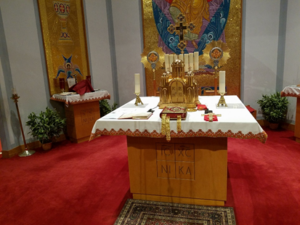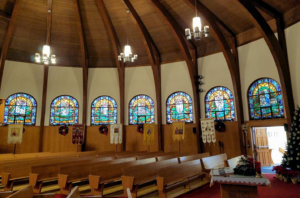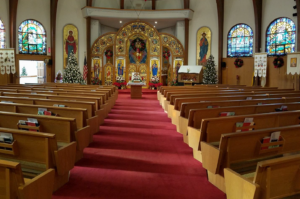Each liturgical tradition has its own requirements and expectations for the liturgical space; here, we will look at the St. Nicholas Church building and its symbolism in the Byzantine tradition.
The Nave
 The most ancient plan of Christian architecture is probably the basilica, the large rectangular room used for public meetings, and many Byzantine churches today are organized around a large liturgical space, called the nave (from the Greek word for a ship, referring to the ark of Noah in which human beings were saved from the flood). The nave is the place where the community assembles for prayer, and symbolically represents the Church “in pilgrimage” – the Church in the world. It is normally adorned with icons of the Lord, the angels and the saints, allowing us to see and remember the “cloud of witnesses” who are present with us at the liturgy.
The most ancient plan of Christian architecture is probably the basilica, the large rectangular room used for public meetings, and many Byzantine churches today are organized around a large liturgical space, called the nave (from the Greek word for a ship, referring to the ark of Noah in which human beings were saved from the flood). The nave is the place where the community assembles for prayer, and symbolically represents the Church “in pilgrimage” – the Church in the world. It is normally adorned with icons of the Lord, the angels and the saints, allowing us to see and remember the “cloud of witnesses” who are present with us at the liturgy.
At St. Nicholas, the nave opens upward to a dome with stained glass of the Eucharist chalice and the Holy Spirit above the congregation. The nave is also provided with lights that at specific times the church interior can be brightly lit, especially at moments of great joy in the services, or dimly lit, like during parts of the Liturgy of Presanctified Gifts.
The nave, where the congregation resides during the Divine Liturgy, at St. Nicholas is round, representing the endlessness of eternity. The principal church building of the Byzantine Rite, the Church of Holy Wisdom (Hagia Sophia) in Constantinople, employed a round plan for the nave, and this has been imitated in many Byzantine church buildings.


The Narthex
If the nave represents the gathered assembly of Christian believers, the narthex (“entry room” or vestibule) represents that part of the world which awaits redemption. In ancient times, those who were not yet baptized, or those who had committed grave or public sins, would go no farther than the narthex, and ask the prayers of those who made their way into the temple.
The initial portions of the baptismal and wedding services take place in the narthex, and during feast-day Vespers, a procession may take place to the narthex to pray for the needs of the world. Doors usually mark the boundary between the narthex and nave and choosing to cross this boundary brings us deeper into the presence of God.
The Sanctuary
The sanctuary (the “holy place” or “holy of holies”), at the opposite end of the nave from the narthex, represents heaven and the heavenly liturgy. In contains a square table, the holy table or altar, at which the sacrifice of the Eucharist is offered. The holy table has many layers of symbolism and represents both Christ and his empty tomb. The Gospel book, a cross, and a tabernacle containing the Body and Blood of Christ (kept for distribution to the sick or dying) are placed on the holy table, along with candles for illumination.
 The sanctuary is usually a semicircular space (called an apse) containing chairs or benches for the clergy along the wall behind the holy table. Like the nave, the sanctuary may be richly adorned with icons. Also within the sanctuary is the table of preparation or prothesis, at which the bread and wine for the Eucharist are prepared for liturgical use.
The sanctuary is usually a semicircular space (called an apse) containing chairs or benches for the clergy along the wall behind the holy table. Like the nave, the sanctuary may be richly adorned with icons. Also within the sanctuary is the table of preparation or prothesis, at which the bread and wine for the Eucharist are prepared for liturgical use.
The Icon Screen (Iconostasis)
A large icon screen or iconostasis is a particular feature of the Byzantine tradition; with doors at the center to allow the clergy to solemnly enter the sanctuary, and smaller doors at the side for access to the sanctuary at other times, it symbolically joins the nave and sanctuary, serving as the “gate of heaven.” The icons here are arranged in a particular pattern, always including our Lord Jesus Christ and his Mother, the patronal saint of this church (St. Nicholas), and the other principal saint of the Byzantine tradition (St. Josaphat). The larger iconostasis includes the twelve Great Feasts of the Byzantine Rite and the Last Supper.
The central doors, called the holy doors, are only used for solemn processions; in fact, for some services such as daily vespers, they are never opened. During the Bright Week following Pascha, the feast of the Resurrection, they are left open for the entire week, to symbolize the fact that because of the Resurrection, “heaven is open to all.” (The holy doors are also sometimes called “royal doors”, but this term is more properly used of the doors from the narthex into to nave; the people who enter these doors are the “royal nation” who have been called out of darkness into the light of Christ; 1 Peter 2:9). The icons of the four Gospel writers (Mathew, Mark, Luke and John) are on the royal doors. The main front doors there are called the royal doors since those were the doors by which the emperor entered the temple. The north deacon’s door and south deacon’s door are on either side of the iconostas. Deacons and servers use these doors for going between the sanctuary and the nave. The Deacon’s doors have icons of either angels or saints on them to indicate the messengers of God. Our Deacon’s doors have the Archangel Michael and St. Stephen the protomartyr.
![]()
The space before the Iconostasis is called the solea, and may extend out in a semicircle into the nave; the priest reads the Gospel from the solea, facing the people, and the deacon stands on the solea, facing the sanctuary, to lead the petitions of the congregation to God.
In the particular tradition of our church, a small four-legged table called the tetrapod may stand before the solea, with an icon of the saint of the day and a cross, which the faithful venerate with a bow and a kiss when they come into the church. At various times, the Gospel book or cross may also be placed on the tetrapod for the people’s veneration.
Stained Glass Windows
St. Nicholas has fourteen stained glass windows. There are seven stained glass windows on the north and south sides of the nave.
The windows depict the fourteen Stations of the Cross:
• First Station – Jesus is condemned to Death
• Second Station – Jesus is made to bear His Cross
• Third Station – Jesus falls the first time under His Cross
• Fourth Station – Jesus meets His Mother
• Fifth Station – Simon the Cyrene helps Jesus carry His Cross
• Sixth Station – Veronica wipes the face of Jesus
• Seventh Station – Jesus falls the second time
• Eighth Station – Jesus speaks to the daughters of Jerusalem
• Ninth Station – Jesus falls the third time
• Tenth Station – Jesus is stripped of His garments
• Eleventh Station – Jesus is nailed to the Cross
• Twelfth Station – Jesus dies on the Cross
• Thirteenth Station – Jesus is taken down from the Cross
• Fourteenth Station – Jesus is buried in the tomb



